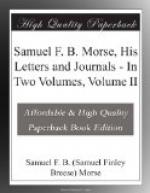Finding that the principal display was not until the afternoon, they strolled to the Lake of Nemi, “situated in a deep basin, the crater of a volcano.” Those Italian lakes which he had so far seen, while lovely and especially interesting from their historical or legendary associations and the picturesque buildings on their shores, seemed to the artist (ever faithful to his native land) less naturally attractive than the lakes with which he was familiar at home—Lake George, Otsego Lake, etc. He had not yet seen Como or Maggiore. Then he touches upon the great drawback to all travelling in Italy:—
“Throughout the day, wherever we went, beggars in every shape annoyed us, nor could we scarcely hear ourselves talk when on the borders of the lake for the swarms which importuned us. A foolish Italian, in the hope probably of getting rid of them, commenced giving a mezzo biochi to each, and such a clamor, such devouring eyes, such pushing and bawling, such teasing importunity for more, and from some who had received and concealed their gift, I could not have conceived, nor do I ever wish again to see so disgusting a sight. The foolish fellow who invented this plan of satisfying an Italian beggar’s appetite found to his sorrow that, instead of thanks, he obtained curses and an increase of importunity....
“After dinner we again walked to Genzano, whither we found were going great multitudes of every class; elegant equipages and vetture racing with each other; donkeys and horses and foot travellers; and not among the least striking were the numbers of women, some of whom were splendidly dressed, all riding on horseback, a foot in each stirrup, and riding with as much ease and fine horsemanship as the men.
“When we arrived at Genzano the decoration of the streets had commenced. Two of the principal and wide streets ascend a little, diverging from each other, from the left side of the common street which goes through the village. The middle of these streets was the principal scene of decoration. On each side of the centre of the street, leaving a good-sized sidewalk, were pillars at a distance of eight or nine feet from each other composed of the evergreen box and tufted at the top with every variety of flowers. They were in many places also connected by festoons of box. The pavement of the street between the pillars in both streets, and for a distance of at least one half a mile, was most exquisitely figured with flowers of various colors, looking like an immense and gorgeously figured carpet.
“The devices were in the following order which I took note of on the spot: first, a temple with four columns of yellow flowers (the flower of the broom) containing an altar on which was the Holy Sacrament. In the pediment of the temple a column surmounted by a halfmoon, which is the arms of the Colonna family. Second was a large crown. Third, the Holy Sacrament again with various rich ornaments. Fourth, stars and circles. Fifth, a splendid coat-of-arms as accurate and rich as if emblazoned in permanent colors, with a cardinal’s hat and a shield with the words ’prudens’ and ’fidelis’ upon it.”




